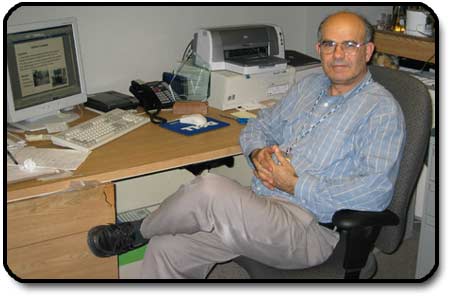

Highlights



|
 |
NRC Researcher Honoured for his Work on the Biological Degradation of Energetic Chemicals
 |
| Dr. Jalal Hawari of the NRC Biotechnology Research Institute (NRC-BRI) |
NRC staff have a world-wide reputation and are often sought out for international collaborations. This reputation grew stronger recently as Dr. Jalal Hawari of the NRC Biotechnology Research Institute (NRC-BRI) received an important U.S. award (the first non-U.S. citizen to do so) for his work on the clean-up of military sites contaminated with energetic chemicals, compounds which are toxic and carcinogenic. In Canada alone, it is estimated that over 100 sites are contaminated with energetic chemicals. This contamination is widespread, affecting both soil and groundwater.
Dr. Hawari was presented with the honour of the Project of the Year Award for Cleanup at a conference in Washington, organized by the Strategic Environmental Research and Development Program (SERDP). SERDP is the environmental R&D program of the U.S. Department of Defense, Department of Energy and Environmental Protection Agency.
 |
Photo of Dr. Jalal Hawari and his NRC-BRI team members.
1st row: Dominic Manno, Manish Bhatt;
2nd row: Frédérique Matteau, Bharat Bushan, Jalal Hawari, Fanny Monteil, Annamaria Halasz, Chantale Beaulieu, Louise Paquet, Vimal Balakrishnan, Jian-Shen Zhao;
3rd row: Stéphane Deschamps, Alain Corriveau, Carl Groom , Diane Fournier |
Since 2001, NRC-BRI's Environmental and Analytical Chemistry Group, led by Dr. Hawari, has been collaborating with Dr. Sonia Thiboutot and Dr. Guy Ampleman, from the environmental laboratory of Canada's Department of National Defence and Professor Jim Spain, Geogia Institute of Technology (previously at the Environmental Division of the U.S. Air Force Research Laboratory), to study the biodegradation of HMX and RDX, two powerful and widely used energetic chemicals. The international team discovered that once bacteria attack these compounds, they auto-decompose into harmless products such as, carbon dioxide and nitrous oxide. These products, RDX in particular, is presently used by the auto industry in car safety bags.
Dr. Hawari's research provided the first true insight into how this biodegradation process actually works. "We discovered key metabolites that led to the understanding of the microbial degradation pathways of these two energetic chemicals," said Dr. Hawari. The breakthrough is critical in developing effective bioremediation tools to clean soil and groundwater contaminated with RDX and HMX.
Findings from this project have resulted in 20 scientific publications and have triggered two new collaborations on related work with the U.S. Office of Naval Research and with the U.S. Army and SERDP. The total value of these collaborations amounts to over $2 million CDN. "This project is a great example of how international collaboration can produce very successful results," said Dr. Michel Desrochers, Director General of NRC-BRI.
Recommended Links
|
